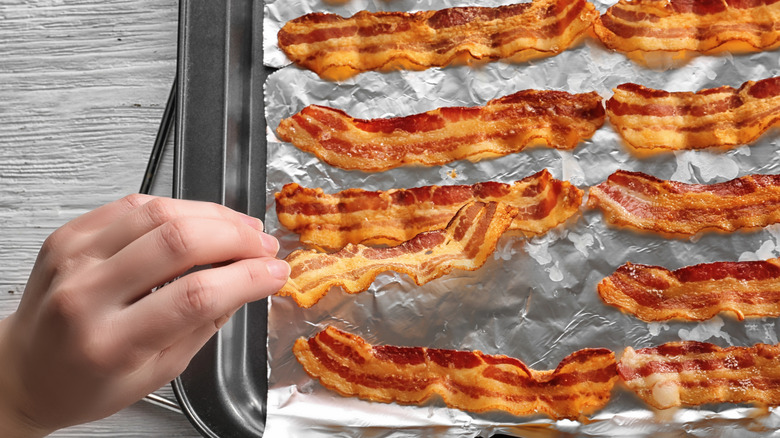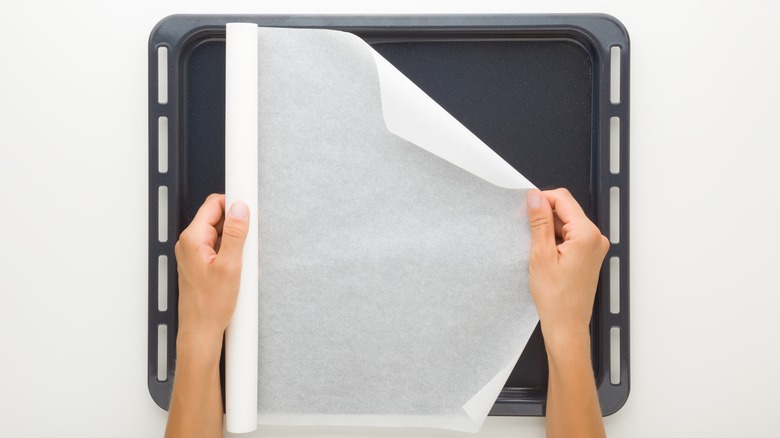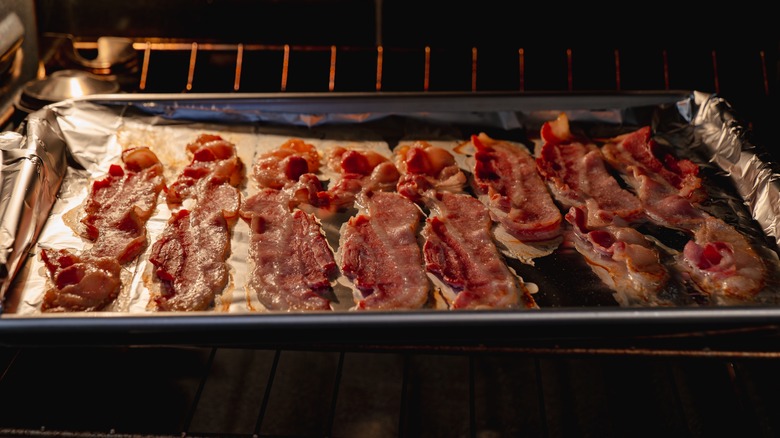Aluminum Foil Vs Parchment Paper: Which Is Better For Cooking Bacon?
Bacon can be cooked in so many ways, from the classic stovetop skillet method to the air fryer, but one of the most foolproof tools has to be the oven. It's great for feeding a crowd, as you can cook bacon in large batches, and it's pretty much mess-free — or is it? Cooking bacon this way doesn't spatter fat everywhere, like it can on the stove, but it will leave you with a lot of grease on your baking tray, as well as your wire rack, if you use one.
For less mess, don't make the mistake of roasting bacon without parchment paper. This kitchen staple makes for easy cleanup, as all you have to do is carefully lift the paper off your tray and chuck it in the trash, then give your baking sheet a scrub. But if you don't have any parchment on hand, you may wonder if aluminum foil will also do the job, or perhaps even better.
There are certainly occasions where parchment paper and aluminum foil are not interchangeable, but when it comes to oven cooking, they both have their advantages. They can prevent bacon from sticking to your tray or wire rack, withstand higher cooking temperatures, and help to reduce mess. Still, there are some small differences in performance. Which one is best pretty much comes down to your personal preference and priorities.
Bacon won't stick to greaseproof parchment paper
One of the key advantages of parchment paper is its non-stick and grease-repellant qualities. Unless your foil is a special non-stick variety, bacon can easily stick to it, unless you oil the foil first. Parchment means no need to use any extra fat when cooking an already-fatty meat. Another reason you might prefer parchment paper is its sturdiness and durability, as it's less prone to tearing than flimsier foil.
Like foil, parchment paper is heat-resistant, but it can be used at temperatures from 420 to 450 degrees Fahrenheit. While some sources say foil can also withstand up to 450 degrees, others say you shouldn't go above 400 degrees. Since the best temperature for cooking bacon is 400 degrees Fahrenheit, this makes either tool suitable, though you may feel more comfortable with parchment at slightly higher temperatures, if you want extra-crispy slices. Whatever you do, don't confuse parchment with wax paper, which melts at a lower heat – you should definitely keep wax paper away from hot ovens.
However, the same nonstick properties that make parchment paper convenient also mean it doesn't hold fatty grease as well as foil does. Bacon fat can easily slip off of the smooth paper, and unlike moldable foil, it can't be easily folded to help contain the grease, unless you're great at origami. If generating less mess is your main concern when cooking a big batch of bacon, it's worth trying foil instead.
Aluminum foil makes for easier cleaning
The best part about using aluminum foil is the simple cleanup. When the bacon is done, you can simply drain off the fat from the foil, then crumple it up and dispose of it. Chances are, you won't need to wash the pan at all afterwards. Foil also makes it easy to save the drippings for future recipes, one of the tasty hacks that all bacon lovers need to know.
In terms of the taste and texture of the finished bacon, there is no real difference between bacon cooked on parchment or foil. Whichever you use, just make sure it's a big-enough sheet to overhang from the edges of the pan, which minimizes mess. If you're not using extra-wide rolls of paper or foil, you can use multiple sheets and overlap them to make sure the entire base of the tray, as well as the four sides, are completely covered.
To ensure success even further, try nudging your bacon strips partway through cooking to stop them from sticking to your oven rack, and if you want completely flat bacon for neater sandwiches, try the sheet pan hack that prevents your bacon from curling. Simply lay another sheet pan on top of your bacon before it goes in the oven, and remember to line both pans with either parchment or foil to make cleaning up a breeze.



